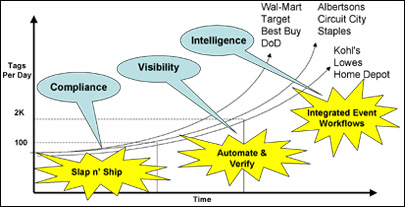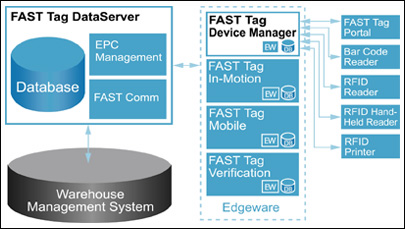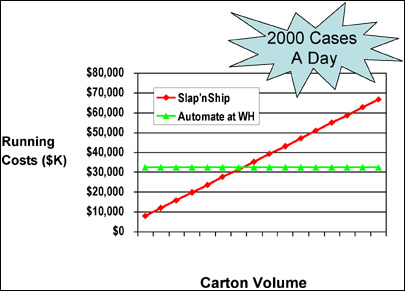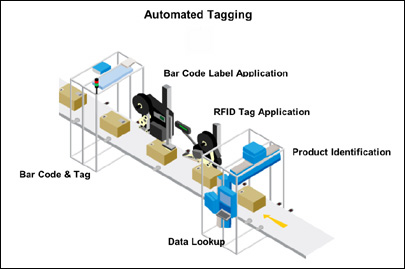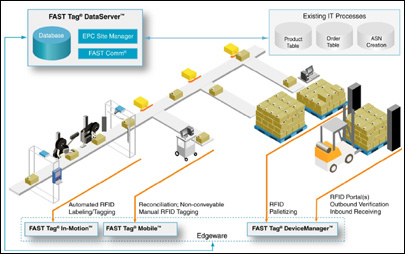Every potential application of RFID tagging requires a different approach. Manufacturers of consumer goods, for instance, require a full range of compliance-tagging and verification solutions. These range from intelligent manual tagging to full, in-line automatic tagging, complete with verification readers, shrink-wrapping and portal read points at transition areas in the warehouse and at shipping dock doors. Building in scalability allows a system to meet initial needs and expand to meet future requirements by reusing or redeploying existing equipment. To that end, it is important to work with a supplier able to provide all the components necessary to solve the RFID compliance puzzle and ensure a successful implementation.
RFID Scalability Rollout
For example, a company might begin with a manual “slap-and-ship” system allows it to comply with RFID mandates. Then, as production increases, they could move to semi-automated and fully automated systems by adding hardware and redeploying existing hardware. Typically, the crossover point from manual to automated installations is about 2,000 tags per day.
|
|
As the system becomes more automated, companies could move from simple compliance to more sophisticated data gathering, to more intelligent workflows. In other words, they could advance from simple tagging through automation and full integration.
The foundation for a scalable RFID rollout strategy is something commonly called edgeware. This software can be understood as distributed intelligence allowing devices “at the edge” of the system (such as RFID tag readers) to communicate with other devices in the system without having to go through a central processor. With the proper edgeware, one can make decisions close to the device level, providing faster throughput and data transfer.
The right edgeware package provides the basis for a controlled rollout strategy based on a company’s changing needs. This approach serves today’s needs and allows a system to grow to meet tomorrow’s needs. It is more cost-effective than either buying an “oversized” software package or purchasing the minimum today and then buying again as needs change. Either of these approaches can result in wasted capital.
Scalable Edgeware/Middleware
RFID provides more data at the edge today than ever before, and the amount of information available will grow with increased volumes, read points and tagging locations. Managing this vast amount of information requires a simple way to collect, filter and transfer and transport data. In addition, the system should be configured to provide a seamless interface to current and future business systems, as well as an upgrade path to support multi-site applications.
The right edgeware provides a foundation for scalability from a simple RFID printer to an automated installation. It also has the modularity needed to support additional devices as they become available. In addition, localized edgeware provides a level of redundancy that will allow intelligent operation through event-based workflows.
RF Expertise—Getting the System Right
Experience counts in designing a quality RFID system. To ensure that the system is designed properly, it is essential to work with a company that has experience with and an understanding of RF to fine-tune the system. Steps to follow to ensure proper operation include:
• Performing a SKU analysis to determine if the products being processed are compatible with radio frequencies.
• Verification of the RF working environment.
• Automation analysis to provide guidance on moving from manual to automated materials handling.
• Integration analysis to ensure that the RFID system integrates into the existing facility seamlessly, and with the least amount of disruption.
SKU Analysis: While RFID tagging provides a number of advantages, it does have some physical limitations. For example, products with high liquid or metal content require special considerations. Liquids absorb some frequencies of radio waves, while some metals can cause unpredictable performance.
Such products may require custom-designed tags or precise tag placement to ensure readability. The location may differ from product to product, and can impact readability drastically.
Verification: Radio frequencies present in the workplace can have a significant effect on the reliability of an RFID system. To ensure success, the system supplier must first assess whether large amounts of metal or stray radio waves are present in the environment and how they may affect operation.
In addition, the RFID system could have an impact on other equipment in the area. Again, an assessment needs to be made on how RF energy generated by the tagging and identification system affects nearby equipment.
A critical point in the verification process is ensuring that objects are properly tagged, and that the tags are readable. This includes determining the best way to read tags. Reading options include:
• Over-conveyor readers that capture each product, package or carton on the line.
• Singulation, which distinguishes among individual products, packages or cartons.
• Portals, stretch-wrap readers and forklift readers able to read multiple RFID tags at once.
What’s more, multiple read points may be required to track the movement of products throughout the facility. The verification of tagged products by RFID systems provides full traceability from manufacturer to retailer. This provides assurance that a product has been shipped and delivered.
Automation: There is a strong similarity between bar-code labeling and RFID tagging in automated material-handling applications. Both processes apply to objects moving on a conveyor, and both may be able to support a multi-product mix.
The key to success lies not only in applying tags properly, but also in understanding and controlling the flow of products through the process. Proper tagging requires verification that the correct tag has been applied to each object. Edgeware is the critical component in verifying the proper placement of tags.
Integration: Once the optimum solution has been chosen and a process is in place, it is easy to assume that the job is complete. In reality, however, only half the work is done. Now it is time to implement the solution.
The challenge is to integrate the RFID system into the facility seamlessly with the least amount of disruption. To minimize problems and downtime, it is important to work with a company that has experience in working with both material-handling hardware and IT integration.
Scalability Options
In considering system-design options to ensure efficient operation today and scalability for tomorrow, one should consider the following questions:
• How are my labels applied today?
Typically, manual systems are sufficient for low-volume tagging. Automated tagging solutions are appropriate when tagging 2,000 items per day, and may be appropriate for lower volumes if labels must be located more accurately to ensure readability.
• What is the present volume, and what will it be in the future?
Answering this question provides guidance on when it might be appropriate to implement different solutions or combinations of solutions.
• What is the SKU mix?
The main consideration here is whether the production line is dedicated to running a single product, or if it handles multiple products. If it is running only a single product, then one can take a batch-processing approach and the line may be configured for that specific product. If a company is handling multiple products, then each product or carton must be uniquely identified by a bar-code scanner or the like to allow the system to differentiate among products.
Intelligent Slap and Ship: Many RFID systems may involve manual application of tags at start-up. Important factors to consider when designing a manual system include:
• Electronic Product Code (EPC) number management to ensure that the right data is programmed into the tag.
• Putting the right tag in the right location. The RFID system should indicate to the operator where to place the tag on specific products to ensure readability.
• Commissioning of product and pallet tags. The RFID system should be able to handle multiple tag form factors, and the ability to manage pallet and carton data.
• Production-reporting capabilities to indicate not only how much product is shipped, but also the system status.
• Integration into an existing IT system.
As volumes grow, automation may offer more cost-effective scalability. Key data inputs to consider when automating include:
• Application Speed—Auto-applicators are six to 10 times faster than manual application.
• Cost of Labor—Labor costs are considerably higher for manual application.
• Cost of Rejects—Typically, the potential for rejects increases as the number of manually applied tags increases.
• Cost of Improperly Placed Tags—Automated solutions consistently place tags where designed, while manual solutions cannot guarantee proper placement.
Scalability Options
Automated Tagging: Automated tagging solutions provide a number of capabilities, including the ability to perform on-demand or batch processing optimized to individual lines. Such equipment also has the capacity to operate multiple applicators to increase throughput. In addition, if necessary, it can place tags on multiple panels of a carton to ensure readability in all environments.
Automated equipment allows users to place tags in optimal locations to ensure readability by the receiver. Automated systems typically include reporting capabilities to monitor performance and simple interfaces to ensure proper operation. Other benefits include:
• Flexibility in designing label and tag formats.
• Support for different types of print engines.
• Singulation and verification of bar codes and tags on all objects.
• Improved security by providing tighter management of tagging equipment.
Full System Visibility: The most advanced RFID tagging systems provide a complete solution that makes it easy to comply with commercial and government RFID initiatives. It consists of a turnkey automated solution for placing, tracking and verifying RFID tags on cartons and pallets. The system integrates seamlessly into existing material-handling and data-handling systems to provide a low-risk upgrade path from conventional bar-code labeling systems. It can incorporate:
• Bar-code identification.
• Bar-code and human-readable labeling.
• RFID tagging.
• RFID tag reading and writing.
• Material-handling controls.
• Data management, including communications with WMS or ERP systems.
Fully automated systems allow users to add automation and data-management tools easily, as they are needed. The base system consists of an inbound bar-code scanner, RF tag applicator, bar-code printer and applicator, tag verifier and outbound bar-code verifier. Also included are controls for in-feed, tracking, verify and reject outputs, and additional configurable I/O and features.
The software runs on a PC platform that can be housed in an industrial enclosure or placed remotely in an office. The software controls all devices, system I/O, diagnostics, communications and reporting functions through an intuitive user interface.
Key features of a fully automated system include on-the-fly tag validation and invalid tag skipping. These processes read and validate tag data before the system applies the tag to a carton. The system also provides 100 percent item tracking and tracing, ensuring that the right tag is placed on the right box.
Fully automated systems provide automatic placement of RFID tags and bar-code labels to reduce the total cost of ownership versus manual systems. They also allow flexible tag placement to optimize read rate. Verification and automatic rejection of defective tags before application to the carton ensures that no defective tags enter the supply chain. Another benefit of an automated solution is the ability to support automatic and mixed-mode or batch-mode operation with full EPC code management. This means the system operates in the mode best suited for operations, applying tags only to those cartons requiring them.
In addition to using automated tagging solutions, a facility can benefit from manual tagging stations to process items requiring reconciliation and non-conveyable items. Manual tagging stations may also generate tags for pallets built to order, ensuring that the operator knows the proper panel to place all RFID tags on the items and pallet.
After all carton and pallet tagging is complete, employees may use stretch-wrap readers, forklift readers and portals to read pallets as they’re built, moved and loaded on trucks for shipment. This tracking ensures that the company keeps proper inventory levels, that it knows the location of tagged items in the facility, and that the staff completes shipping orders as expected and provides critical business intelligence of product and order flow throughout a facility.
Finally, a well-designed RFID-tagging solution includes full integration into existing IT environments, while providing configurability to adapt to new business-intelligence systems. This IT integration ensures that critical tagging data and line-performance metrics are available in real-time to the enterprise to ensure that a facility is running at optimal performance.
RFID and the Future
Many expect RFID to provide huge advantages throughout the supply chain. In manufacturing, RFID will help managers respond more quickly to market demands and do a better job of planning production. In distribution centers, it will facilitate the automation of inventory counts and speed shipping and receiving. For retailers, RFID will help reduce stock-outs, enable product tracking, potentially reduce theft and streamline point of sale transactions.
We can only speculate on the future of RFID. Many of today’s technologies continue to evolve, including chipless tags, conductive inks, tags integrated in corrugate and packaging, multifrequency tags, semi-active tags, dust networking, etc. Before companies can leverage this evolving technology for maximum effect in their supply chain, it is imperative to implement a scalable solution that not only satisfies today’s needs, but also allows for future growth.
Mike Kuhno is an RFID solutions specialist with Accu-Sort Systems, an auto-ID solutions provider based in Telford, Pa. As a product-line manager, he oversaw the development of the FAST Suite, which standardized Accu-Sort’s products for labeling, sorting and inventory management.



